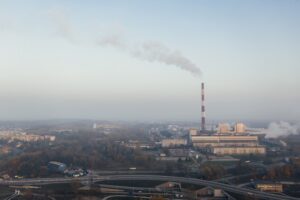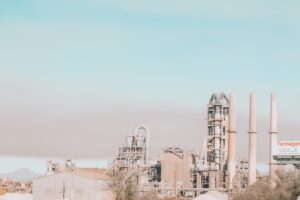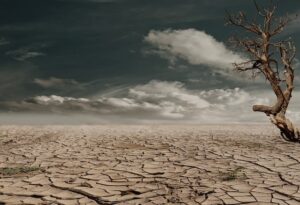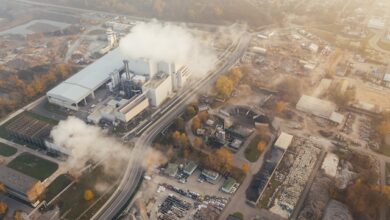The main sources of greenhouse gases and their impact on the environment

Introduction
Greenhouse gases are gases that trap heat in the Earth’s atmosphere, contributing to the greenhouse effect and global warming. These gases are released into the atmosphere through various human activities and natural processes.
Ina addition to, Some of these gases are carbon dioxide, methane, nitrous oxide, ozone, and chlorofluorocarbons (CFCs). Humans have been releasing more greenhouse gases into the atmosphere than the natural processes can absorb.
As a result, the concentration of greenhouse gases has increased significantly. This has resulted in a rise in the global mean temperature of the Earth’s surface.
Further, Human activity is the main source of greenhouse gases. Fossil fuel combustion produces carbon dioxide, methane, and nitrous oxide, among other gases. This article will discuss the main sources of greenhouse gases and their impact on the environment.

Sources of Greenhouse Gases
Burning Fossil Fuels
Fossil fuels such as coal, oil, and gas are major sources of energy around the world. More than 80% of the world’s energy is derived from fossil fuels. The burning of fossil fuels has led to significant climate change.
Further, Climate change is the result of changes in the atmosphere, such as increases in the levels of carbon dioxide and other green house gases, as well as decreases in the levels of sulfur dioxide and nitrogen oxides. The burning of fossil fuels has caused the earth’s temperature to increase, and this is known as global warming.
Moreover, Global warming is expected to result in extreme weather conditions, including heavy rains, droughts, and hurricanes. As the global temperatures increase, so do the sea levels, which will affect coastal areas and low-lying regions.

Deforestation
Deforestation is another significant source of greenhouse gas emissions. It is the process of removing trees and other vegetation from an area of land. When trees are cut down, they release the carbon dioxide that they have absorbed during their growth back into the atmosphere.
Further, This is because trees take in carbon dioxide during photosynthesis and store it in their leaves, stems, and roots. When they are cut down, this carbon is released into the atmosphere through the process of decomposition or burning.
Moreover, The release of carbon dioxide from deforestation contributes to the greenhouse effect, trapping heat in the Earth’s atmosphere and causing global warming. The greenhouse effect occurs when gases like carbon dioxide, methane, and nitrous oxide absorb and re-emit heat, preventing it from escaping into space.
This results in rising temperatures and changes in the Earth’s climate, with potentially devastating consequences for human societies and natural ecosystems.

Agriculture
Agriculture is one of the major sources of greenhouse gas emissions. Livestock, including cows and sheep, are the largest emitters of methane. Farmers often feed their animals with grain instead of grass or other vegetation. This increases the amount of methane that they release into the atmosphere.
Further, The manure that is produced when these animals eat is also a source of methane. However, cows are more effective than sheep in terms of methane emissions. Cows can produce a lot of methane when they are fed grain. Cows that are fed grass have fewer methane emissions.
Moreover, The use of nitrogen fertilizers in agriculture also releases nitrous oxide into the atmosphere. Nitrogen is a major component of fertilizers. Fertilizers contain nitrogen because plants need it. Nitrous oxide is a greenhouse gas that is 25 times more potent than carbon dioxide. It is also more harmful than carbon dioxide.

Industrial Processes
Industrial processes such as cement production, metal smelting, and chemical manufacturing produce energy in the form of heat and mechanical work. When they are done properly, the process produces clean water and purified minerals and metals.
Additionally, They can also produce raw materials that can be used in other manufacturing processes. However, some industrial processes can be very harmful to the environment. In some cases, they can even be dangerous to human health.
Further, Cement production is one of the worst industrial processes that produce large amounts of greenhouse gases. Cement is made by mixing limestone and clay with water. The process generates large amounts of carbon dioxide and other greenhouse gases.
However, Most cement production facilities have chimneys that expel tons of these gases into the atmosphere. Some of these cement factories also produce dioxins, which are carcinogenic compounds that can damage human reproductive organs.

Impact of Greenhouse Gases on the Environment
The impact of greenhouse gases on the environment is significant and includes:
Climate Change
Climate change is one of the biggest environmental problems we are facing today. It is caused by human activities such as deforestation, greenhouse gas emissions, and the burning of fossil fuels. These human activities lead to the emission of large amounts of carbon dioxide into the atmosphere.
Moreover, This leads to the creation of greenhouse gases. The main greenhouse gas is carbon dioxide. This gas traps heat inside the Earth and makes the planet warm. This warming leads to changes in weather patterns, water supply, and other aspects of our environment.
Importantly, Rising temperatures can cause serious consequences such as sea-level rise, glacier melting, coastal flooding, drought, increased frequency and intensity of tropical cyclones, and more frequent and intense heat waves.

Air Pollution
Greenhouse gases, particularly those released through the burning of fossil fuels, also contribute to air pollution, which can lead to respiratory and cardiovascular problems
Additionally, Air pollution has been linked to heart attacks, asthma, lung cancer and other health problems. When you go outside, you will notice that your breath smells bad. This is because the air contains pollutants such as carbon dioxide, nitrogen oxides, ozone and sulfur dioxides.
Further, These are pollutants that are produced by cars, power plants, factories and other places where people use energy. Greenhouse gases, particularly those released through the burning of fossil fuels, also contribute to air pollution, which can lead to respiratory and cardiovascular problems.
Moreover, These pollutants also lead to acid rain and smog. These gases trap heat near the surface of the earth. If you go outside, you will notice that the air becomes warmer. This is because the greenhouse gases keep the earth warm.

Ocean Acidification
As the oceans absorb carbon dioxide from the atmosphere, the water becomes more acidic. This process is called ocean acidification.
Further, In order to understand the impact that carbon dioxide has on the ocean, think about the role that water plays in the ocean. Water is used in a variety of ways by living organisms. The ocean absorbs carbon dioxide from the atmosphere. Water molecules attract the oxygen in the air and make carbon dioxide water.
Moreover, That’s how the oceans become more acidic. As the water gets more acidic, it also changes the chemistry of the ocean. That means that it can affect how marine life functions.
For example, calcium and magnesium dissolve into the ocean water as it becomes more acidic. This will affect shell growth in sea creatures. Some animals, such as oysters, shells in the ocean. The shells have an acidic layer on them.

Biodiversity Loss
Climate change and other environmental impacts of greenhouse gases can have a significant impact on biodiversity. As the Earth’s temperature rises due to the accumulation of greenhouse gases in the atmosphere, habitats that support many species are altered, resulting in changes in migration patterns, reproduction cycles, and food availability.
Further, These changes can lead to the loss of biodiversity as species are unable to adapt to changing conditions. For example, rising temperatures can cause shifts in the timing of seasonal events such as plant flowering, insect emergence, and bird migration. This can cause a mismatch between the timing of these events, making it difficult for species to find food and reproduce.
Moreover, Changes in precipitation patterns can also impact habitats, making it difficult for species to survive and thrive. The impacts of climate change and greenhouse gas emissions on biodiversity are complex and can be far-reaching.
However, It is essential to address these issues through policies and actions that prioritize the protection and conservation of biodiversity, while also working to reduce greenhouse gas emissions and mitigate the impacts of climate change.

Conclusion
Greenhouse gas emissions from burning fossil fuels, deforestation, and agriculture are major contributors to global warming and other environmental problems. Reducing these emissions will require significant changes in how we produce and consume energy, as well as how we manage land and agriculture.
However, By taking action to reduce greenhouse gas emissions, we can help mitigate the impacts of global warming and protect the environment for future generations.



